Study on the Nucleation and Growth of Pearlite Colony and Impact Toughness of Eutectoid Steel
Abstract
1. Introduction
2. Materials and Methods
3. Results
3.1. Microstructural Parameters
3.2. Mechanical Properties
3.3. Fracture Morphology
4. Discussion
4.1. The Nucleation and Growth Mechanism of the Pearlite Colony
4.2. Effect of Microstructure Parameters on Impact Toughness and Strength
4.3. Crack Propagation Path
5. Conclusions
- (1)
- The austenite grain size increases with the austenitizing temperature, while the pearlite colony size was relatively constant. The reason for this result is that the pearlitic steel with complete eutectoid structure has more nucleation sites at the grain boundary than the hypoeutectoid steel and hypereutectoid steel. The pearlite colonies randomly nucleate at the grain boundary and grow into the interior of the grains. Simultaneously, the new pearlite colonies nucleate next to the existing pearlite colonies, and the intragranular pearlite colonies are also randomly nucleated. These nucleation sites increase the chance of the growing pearlite colonies colliding with each other, eventually resulting in a constant pearlite colony size.
- (2)
- The prior austenite grains have a lesser relationship with the strength, conforming to a Hall–Petch-type relationship. The smaller the prior austenite grains, the higher the strength and the better the plasticity. However, the prior austenite grain size has no impact on the impact toughness. The control unit for determining the impact toughness of pearlitic steel is the pearlite colony size.
- (3)
- The impact cleavage crack propagation path of pearlitic steel is facilitated by the following: (A) being perpendicular to the pearlite sheet, (B) the phase interface between ferrite and cementite, (C) a shear deformation of 45° with the cementite sheet, and (D) cracking along the perlite colony boundary.
Author Contributions
Funding
Conflicts of Interest
References
- Liang, Y.L.; Xiang, S.; Yang, M.; Liang, Y.; Yang, X.D. Effect of the interlamellar spacing on mechanical properties of SWRS82B wire rod before and after drawing. Adv. Mater. Res. 2010, 146–147, 374–377. [Google Scholar] [CrossRef]
- Wong, J.N.; Chul, M.B.; Sei, J.O.; Kwon, S.-J. Effect of interlamellar spacing on cementite dissolution during wire drawing of pearlitic steel wires. Scr. Mater. 2000, 45, 1469–1472. [Google Scholar]
- Toribio, J. Relationship between microstructure and strength in eutectoid steels. Mater. Sci. Eng. A 2004, 387–389, 227–230. [Google Scholar] [CrossRef]
- Modi, O.P.; Deshmukh, N.; Mondal, D.P.; Jha, A.K.; Yegneswaran, A.H.; Khaira, H.K. Effect of interlamellar spacing on the mechanical properties of 0.65% C steel. Mater. Charact. 2001, 46, 347–352. [Google Scholar] [CrossRef]
- Toribio, J.; González, B.; Matos, J.C.; Ayaso, F.J. Influence of microstructure on strength and ductility in fully pearlitic steels. Metals 2016, 6, 318. [Google Scholar] [CrossRef]
- Elwazri, A.M.; Wanjara, P.; Yue, S. The effect of microstructural characteristics of pearlite on the mechanical properties of hypereutectoid steel. Mater. Sci. Eng. A 2005, 404, 91–98. [Google Scholar] [CrossRef]
- Yahyaoui, H.; Sidhom, H.; Braham, C.; Baczmanski, A. Effect of interlamellar spacing on the elastoplastic behavior of C70 pearlitic steel: Experimental results and self-consistent modeling. Mater. Des. 2014, 55, 888–897. [Google Scholar] [CrossRef]
- Aranda, M.M.; Kim, B.; Rementeria, R.; Capdevila, C. Effect of prior austenite grain size on pearlite transformation in a hypoeuctectoid Fe-C-Mn Steel. Mater. Trans. 2014, 45, 1778–1786. [Google Scholar] [CrossRef]
- Gladman, T.; McIvor, I.D.; Pickering, F.B. Some aspects of the structure-property relationships in high-carbon ferrite-pearlite steels. J. Iron Steel Inst. 1972, 210, 916–930. [Google Scholar]
- Hyzak, J.M.; Bernstein, I.M. The role of microstructure on the strength and toughness of fully pearlitic steels. Metall. Trans. 1976, 7A, 1217–1224. [Google Scholar] [CrossRef]
- Liang, Y.; Xiang, S.; Liang, Y.L.; Yang, M. Effect of prior austenite grain size on microstructure and toughness of pearlitic steel. Mater. Rev. 2017, 31, 77–81. [Google Scholar]
- Sakamoto, H.; Toyama, K.; Hirakawa, K. Fracture toughness of medium-high carbon steel for railroad wheel. Mater. Sci. Eng. A. 2000, 285, 288–292. [Google Scholar] [CrossRef]
- Kavishe, F.P.L.; Baker, T.J. Effect of prior austenite grain size and pearlite interlamellar spacing on strength and fracture toughness of a eutectoid rail steel. Mater. Sci. Technol. 1986, 2, 816–822. [Google Scholar] [CrossRef]
- Mittemeijer, E.J. Fundamentals of Materials Science, 3rd ed.; Springer: Heidelberg, Gemany, 2011; pp. 371–461. [Google Scholar]
- Madariaga, I.; Gutiérrez, I. Role of the particle-matrix interface on the nucleation of acicular ferrite in a medium carbon microalloyed steel. Acta Metall. 1999, 47, 951–960. [Google Scholar] [CrossRef]
- Madariaga, I.; Gutiérrez, I. Nucleation of acicular ferrite enhanced by the precipitation of CuS on MnS particles. Scr. Mater. 1997, 37, 1185–1192. [Google Scholar] [CrossRef]
- Offerman, S.E.; Wilderen, L.J.G.W.; Dijk, N.H.; Sietsma, J. In-situ study of pearlite nucleation and growth during isothermal austenite decomposition in nearly eutectoid steel. Acta Metall. 2003, 51, 3927–3938. [Google Scholar] [CrossRef]
- Offerman, S.E.; Wilderen, L.J.G.W.; Dijk, N.H. Cluster formation of pearlite colonies during the austenite/pearlite phase transformation in eutectoid steel. Phys. B. 2003, 335, 99–103. [Google Scholar] [CrossRef]
- Martín, M.; Raposo, M.; Prat, O. Pearlite development in commercial hadfield steel by means of isothermal reactions. Metallogr. Microstruct. Anal. 2017, 6, 591–597. [Google Scholar] [CrossRef]
- Fernandez-vicente, A.; Carsi, M.; Penalba, F.; Ruano, O.A. The fracture toughness of a ultrahigh carbon steel containing 1.5 wt% C. Fatigue Fract. Engng. Mater. Struct. 2006, 29, 817–828. [Google Scholar] [CrossRef]
- El-Shabasy, A.B.; Lewandowski, J.J. Effects of microstructural changes, loading conditions and test temperature on toughness of fully pearlitic eutectoid steel used in transportation industry. Mater. Sci. Technol. 2013, 25, 369–378. [Google Scholar] [CrossRef]
- Park, Y.J.; Bernstein, I.M. The process of crack initiation and effective grain size for cleavage fracture in pearlitic eutectoid steel. Metall. Trans. 1979, 10A, 1653–1664. [Google Scholar] [CrossRef]
- Zhang, M.X.; Kelly, P.M. The morphology and formation mechanism of pearlite in steels. Mater. Charact. 2009, 60, 545–554. [Google Scholar] [CrossRef]
- Lewandowski, J.J.; Thompson, A.W. Effects of the prior austenite grain size on the ductility of fully pearlitic eutectoid steel. Metall. Trans. 1986, 17A, 461–472. [Google Scholar] [CrossRef]
- He, Y.; Xiang, S.; Shi, W. Effect of microstructure evolution on anisotropic fracture behaviors of cold drawing pearlitic steels. Mater. Sci. Eng. A 2017, 683, 153–163. [Google Scholar] [CrossRef]
- Li, S.; Yip, T.H.; Ramanujan, R.V.; Liang, M.H. In situ TEM studies of the mechanisms of crack nucleation and propagation in fully lamellar microstructures. Mater. Sci. Technol. 2013, 19, 902–906. [Google Scholar] [CrossRef]
- Xu, Y.; Liu, M.Z.; Zhu, G.Q.; Yu, Z. An in situ observation of deformation and fracture process in metal part I-The deformation and fracture in pearlitic structure. Acta Metall. Sin. 1980, 16, 485–506. [Google Scholar]
- Huang, X.; Guo, W. TEM investigation on microstructure and fracture process of a pearlitic steel. Acta Metall. Sin. 1987, 23, 200–310. [Google Scholar]
- Ghosh, A.; Kundu, S.; Chakrabarti, D. Effect of crystallographic texture on the cleavage fracture mechanism and effective grain size of ferritic steel. Scr. Mater. 2014, 81, 8–11. [Google Scholar] [CrossRef]
- Zhou, S.; Zuo, Y.; Li, Z. Microstructural analysis on cleavage fracture in pearlitic steels. Mater. Charact. 2016, 119, 110–113. [Google Scholar] [CrossRef]
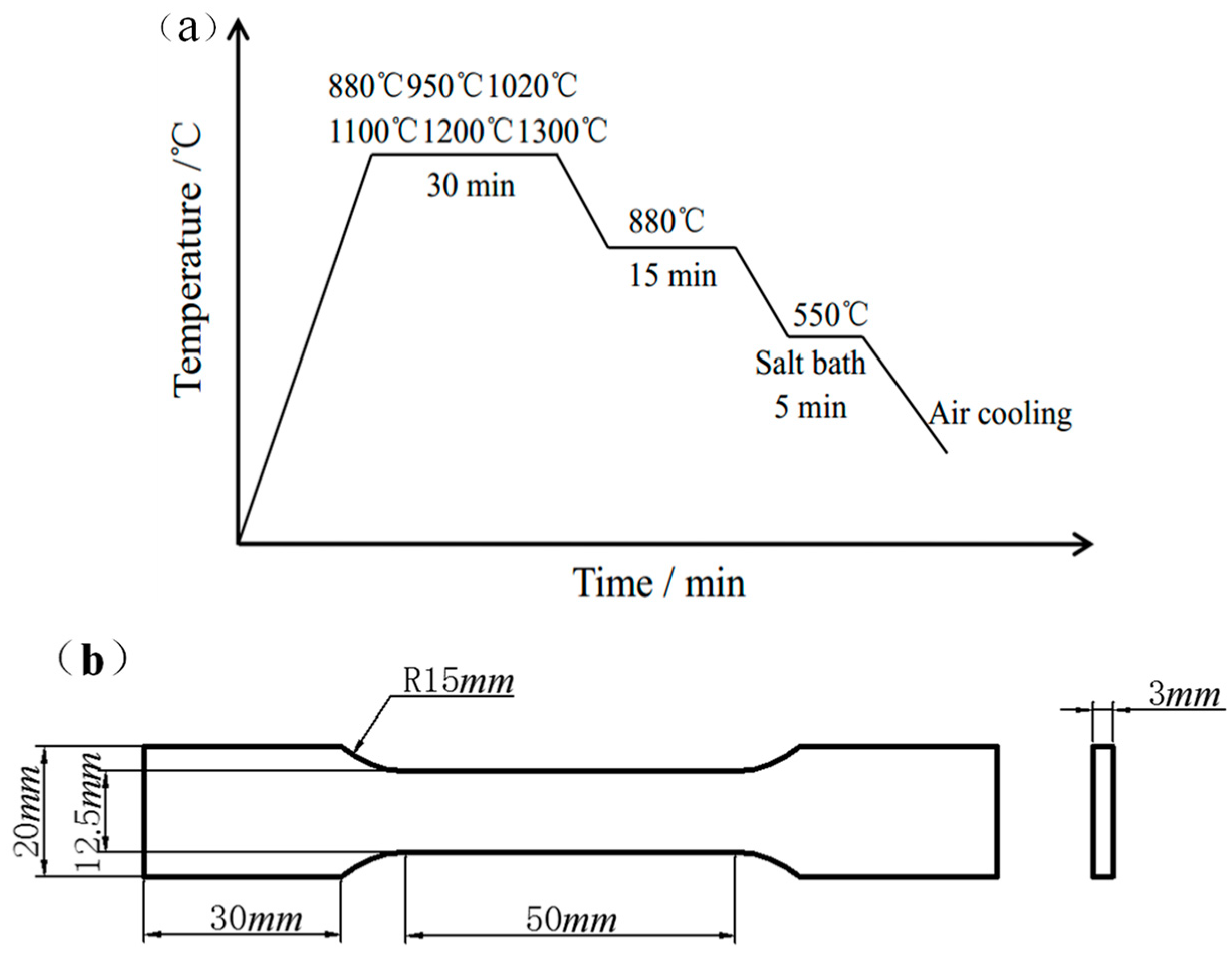
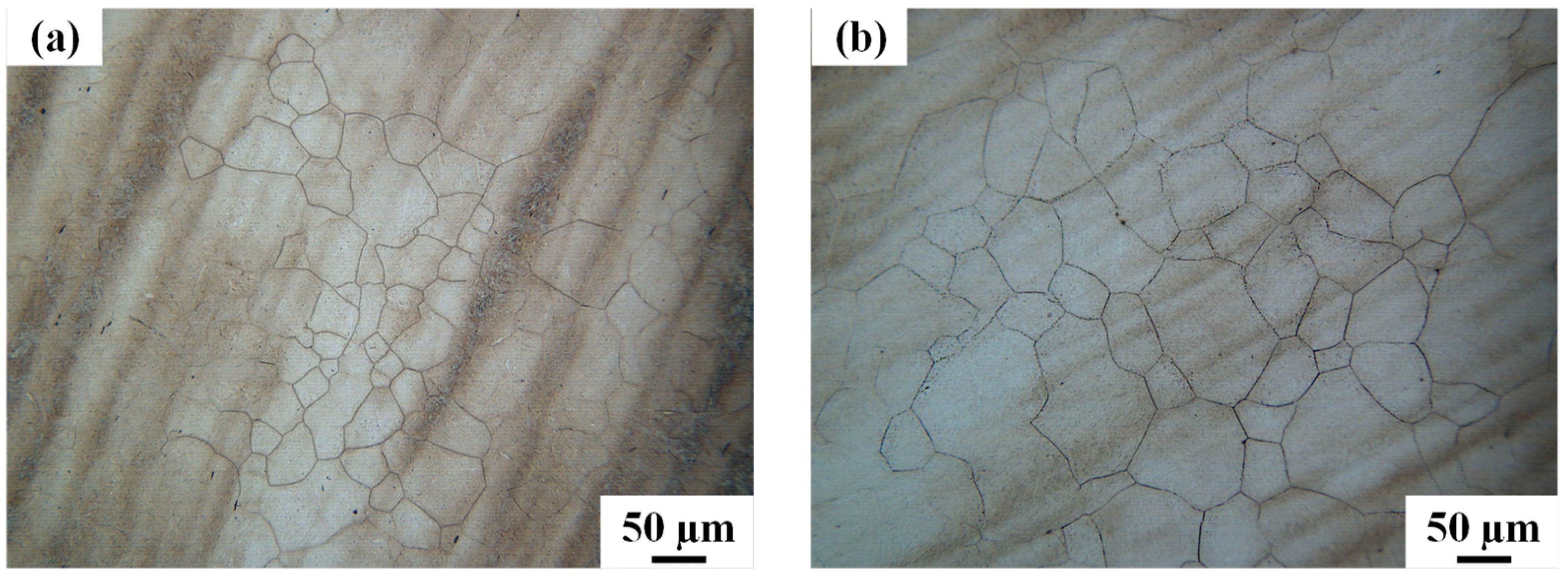
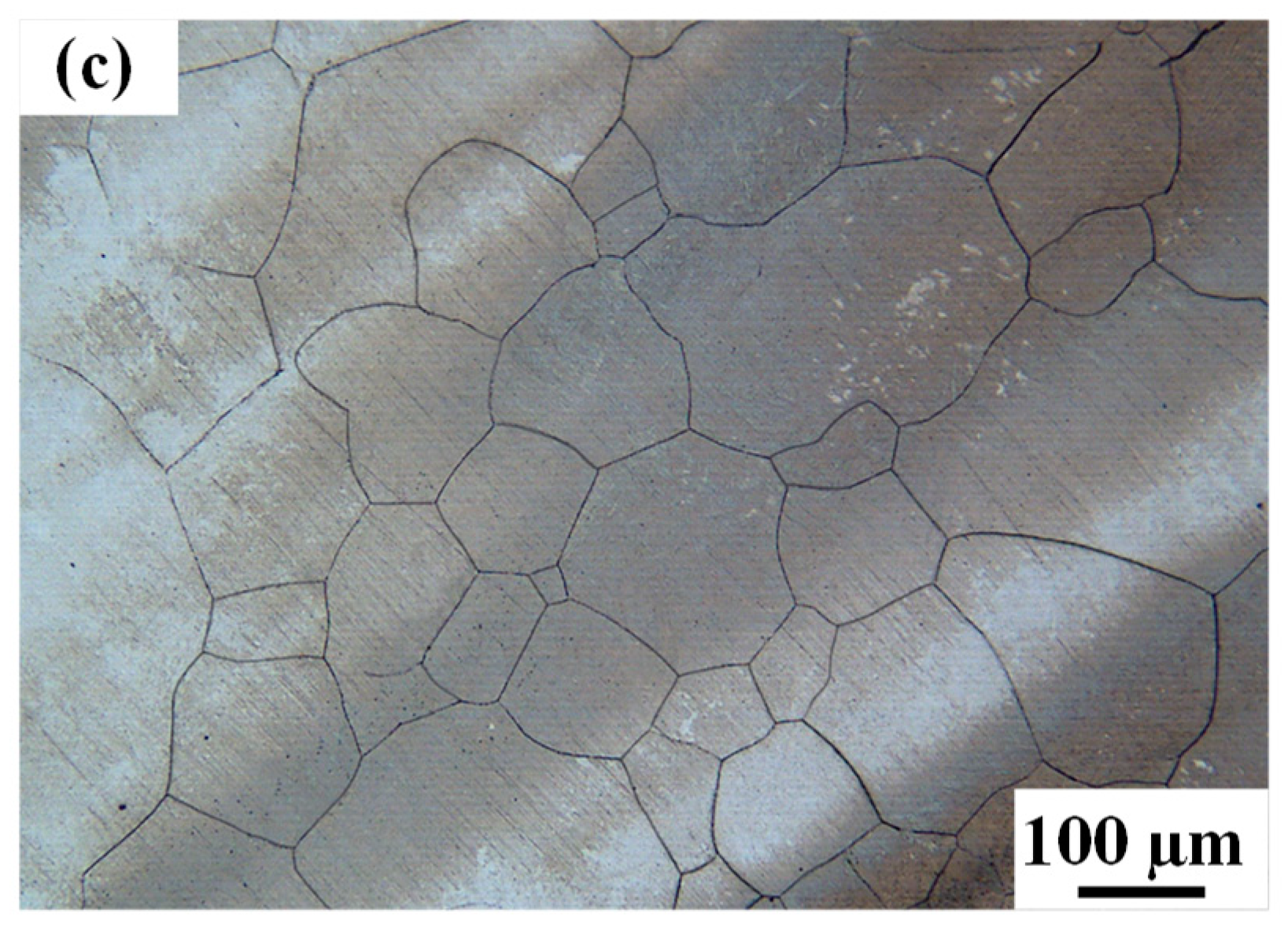
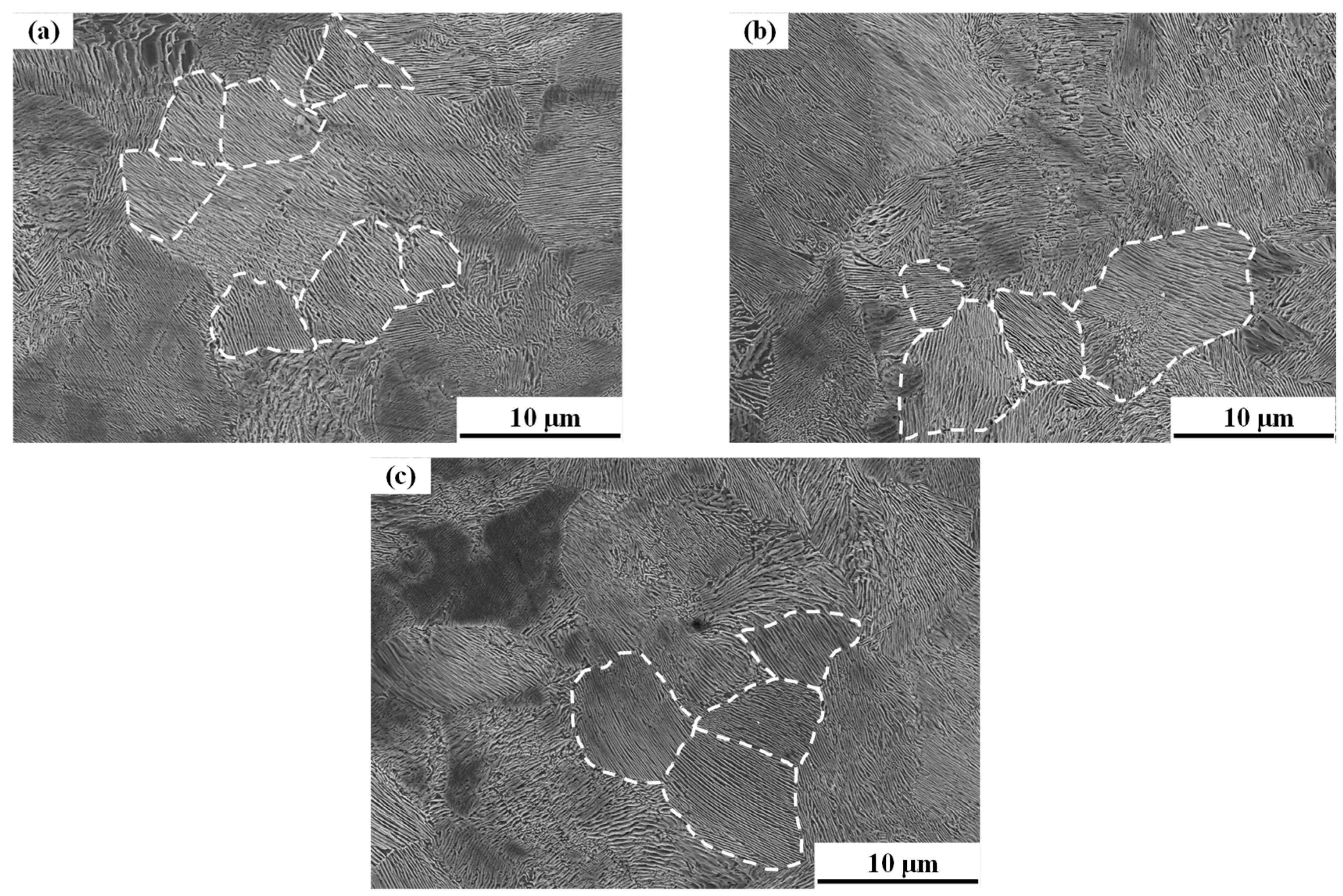

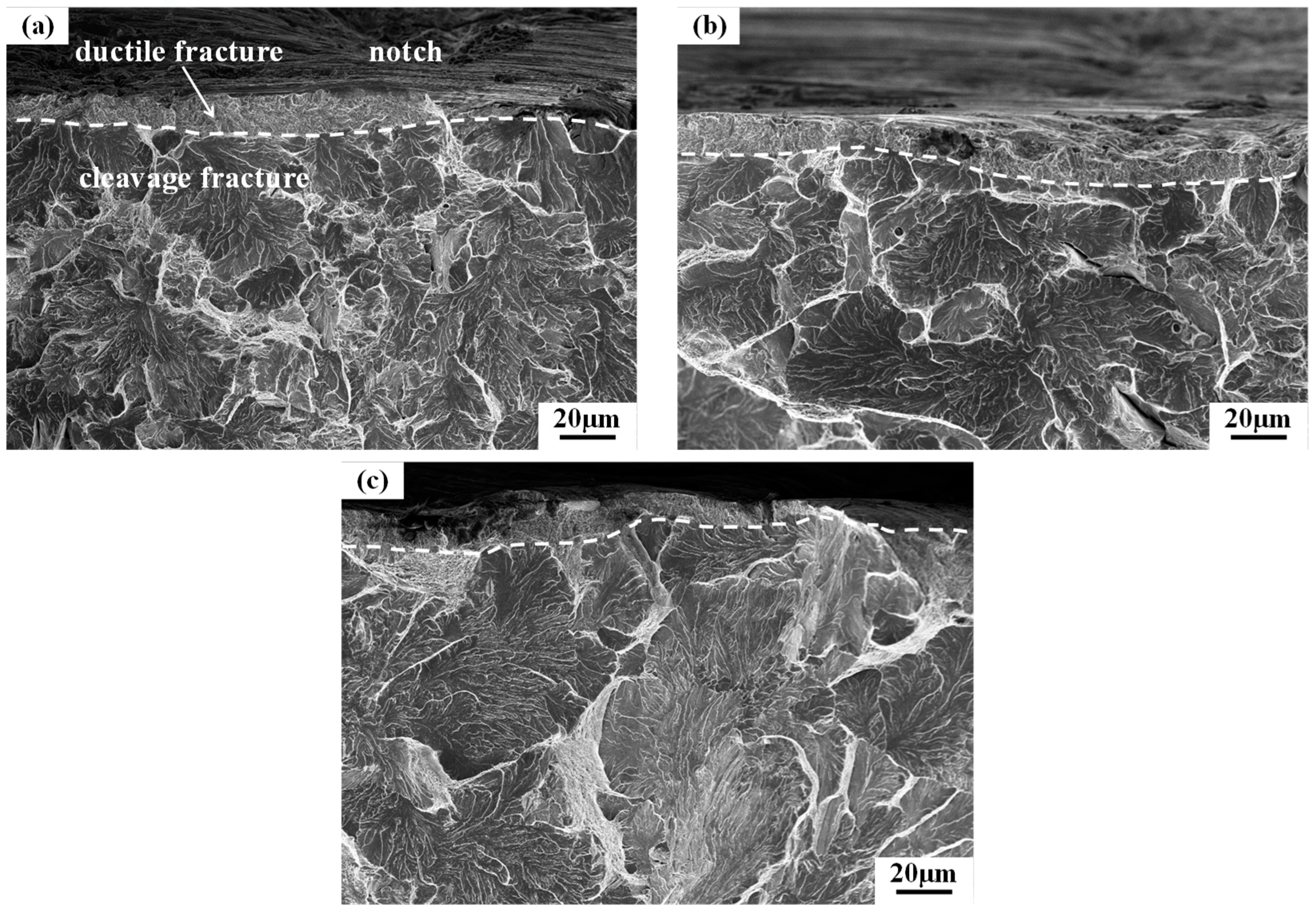
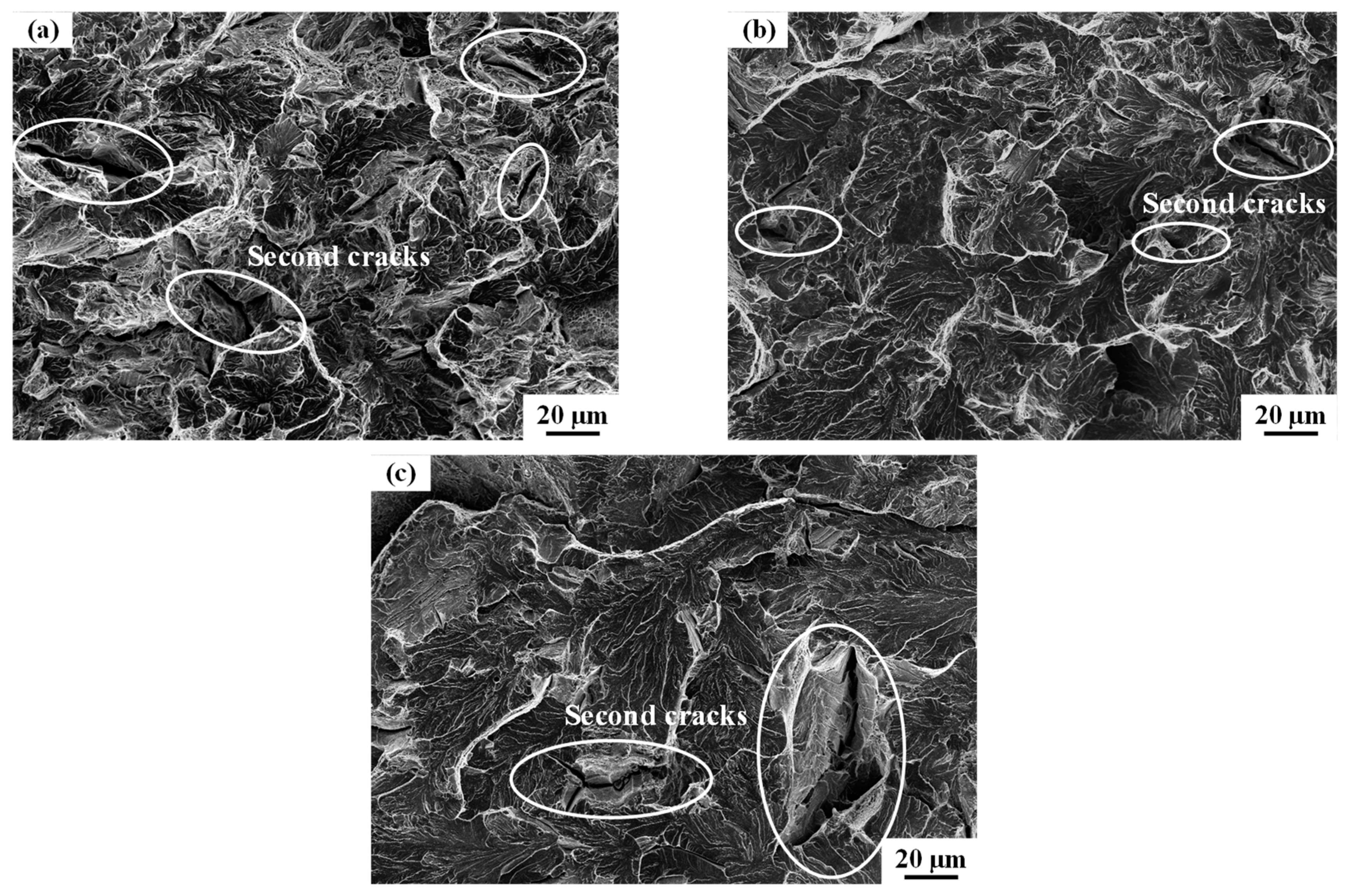
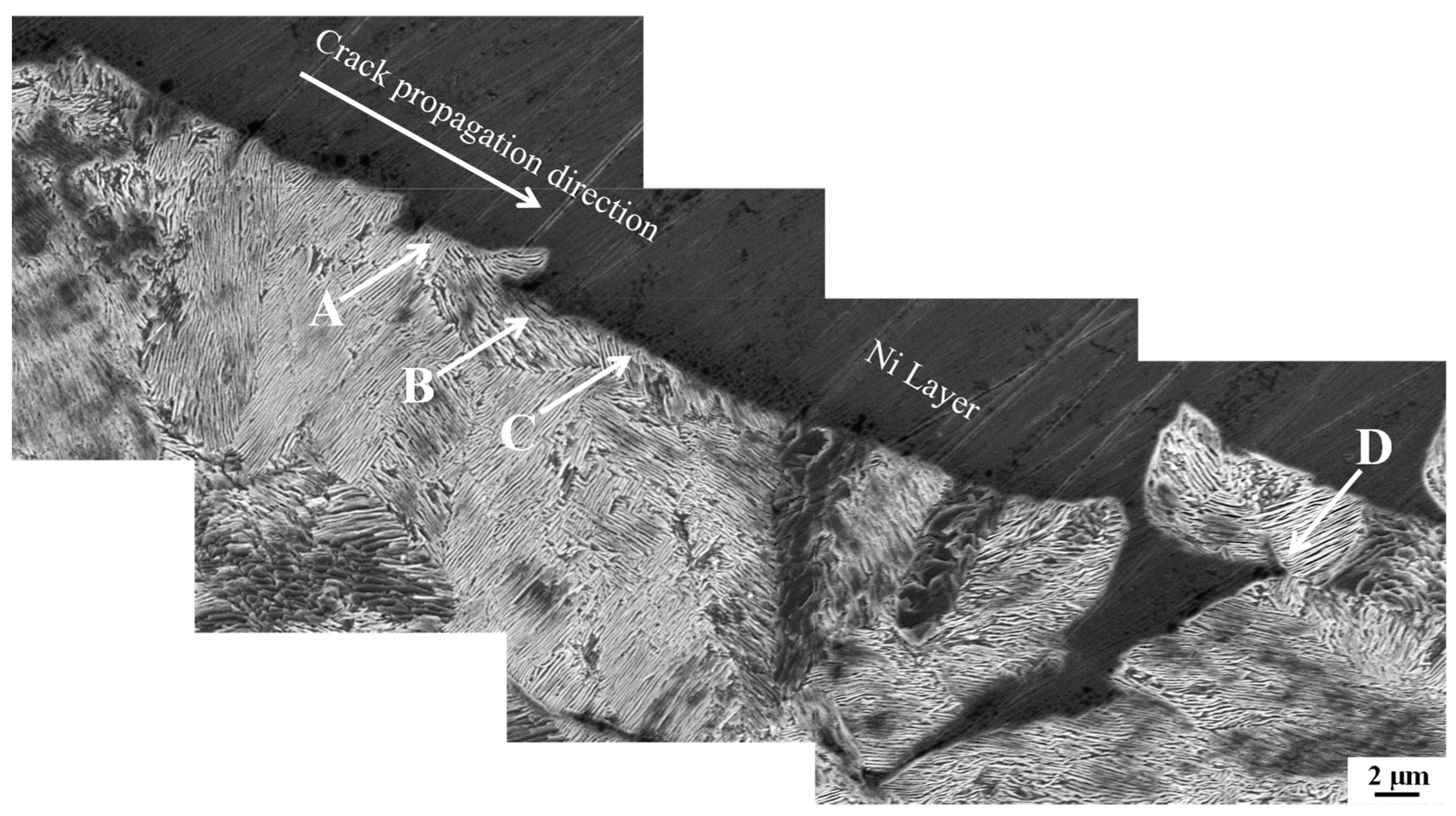
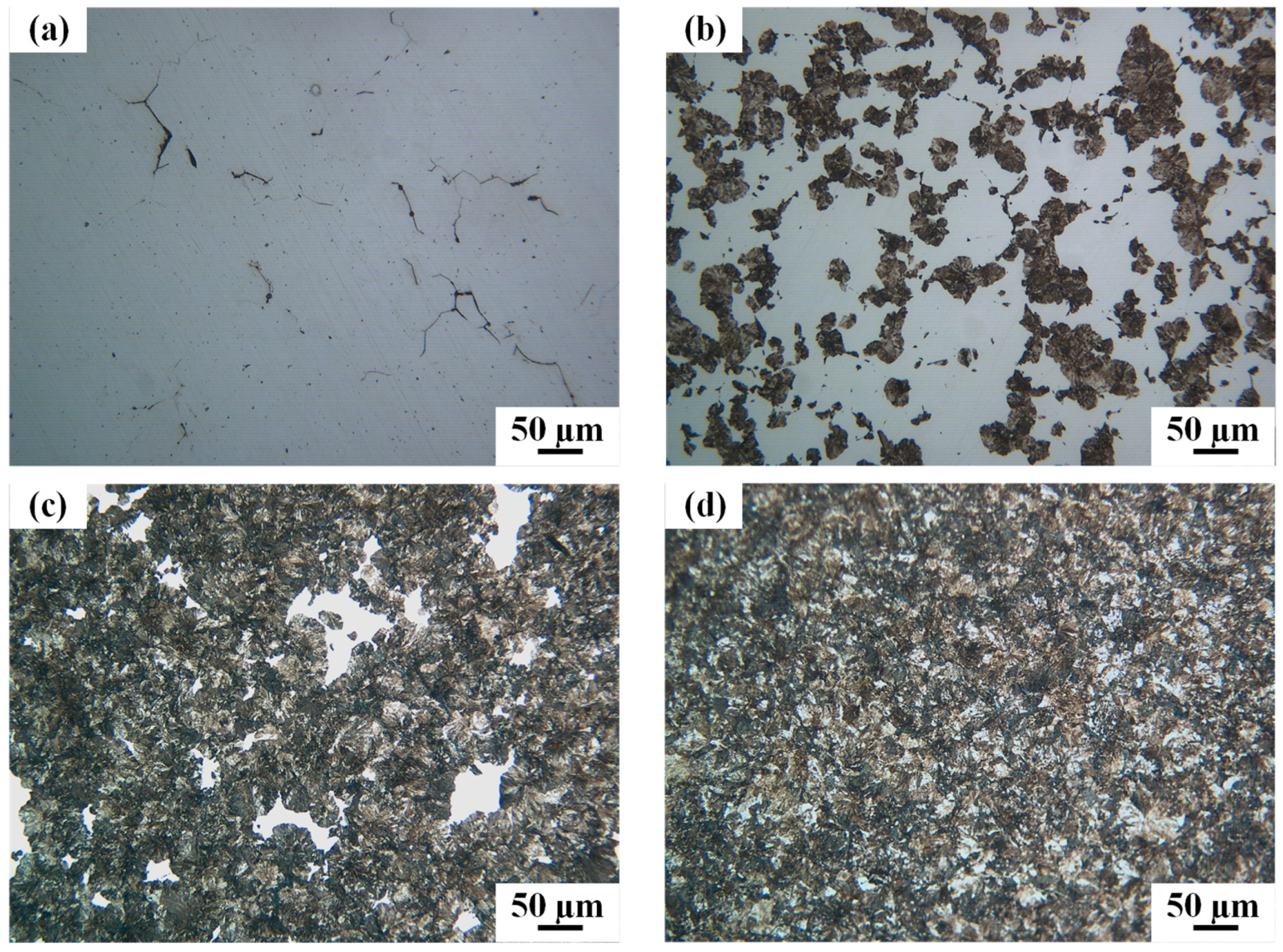
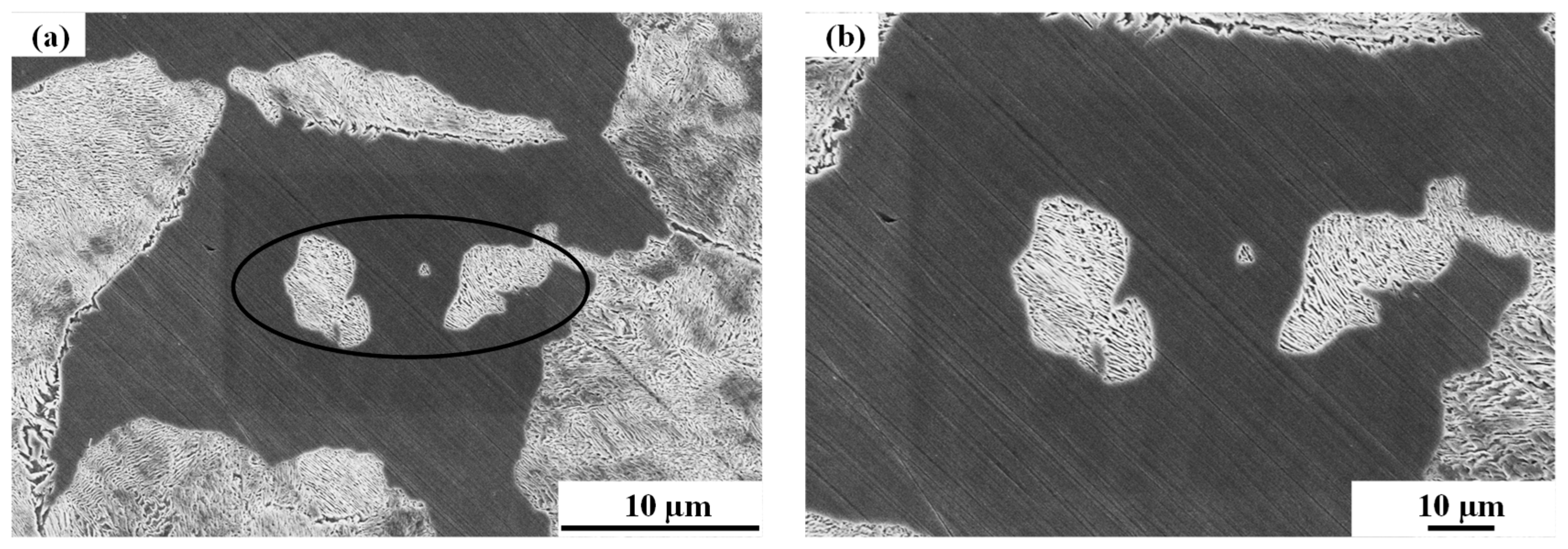

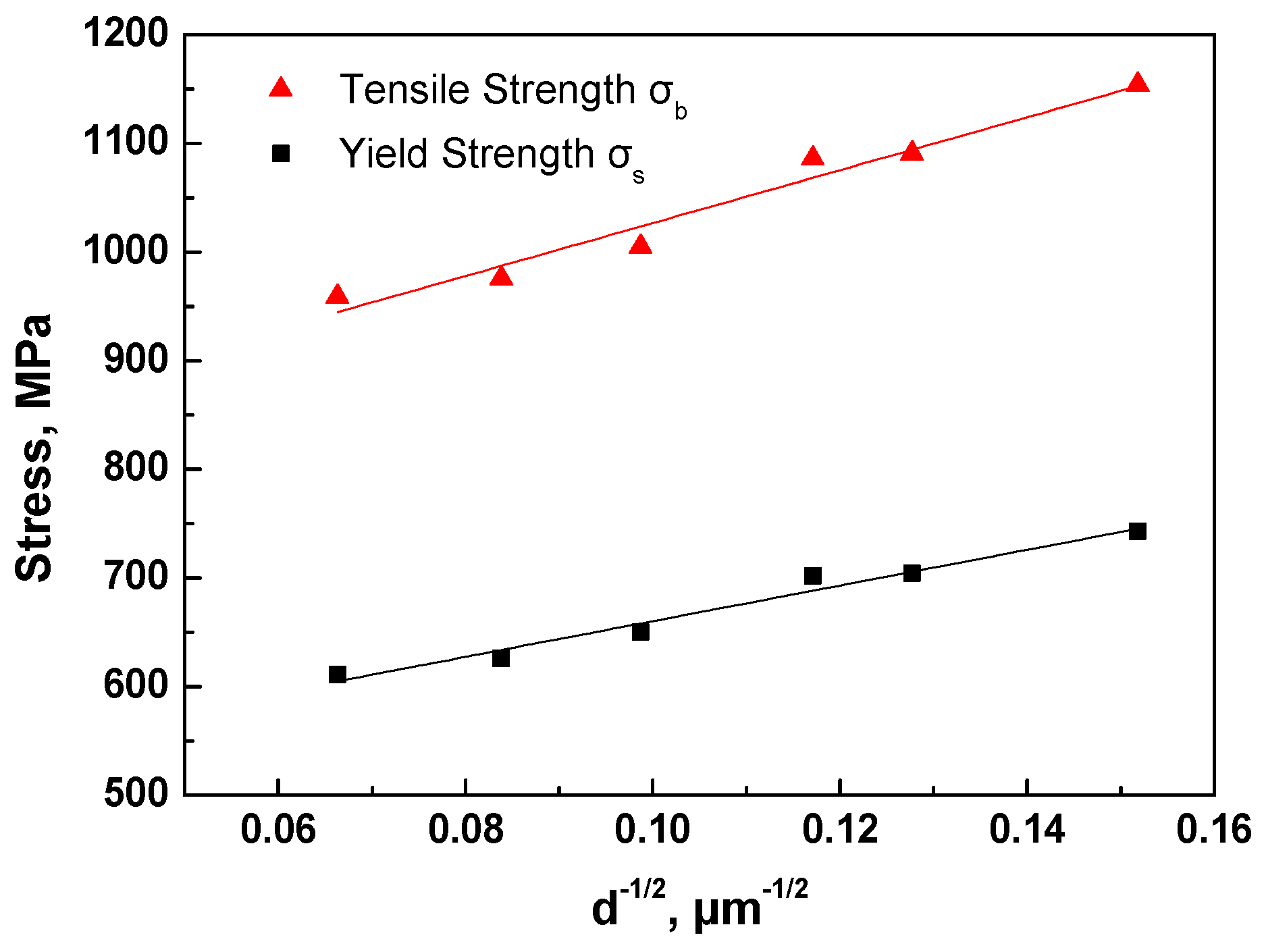
| C | Si | Mn | P | Cr | Fe |
|---|---|---|---|---|---|
| 0.810 | 0.180 | 0.840 | 0.014 | 0.272 | Bal. |
| Austenitizing temperature/°C | Prior austenite grain diameter/μm | Pearlite colony diameter/μm | Interlamellar spacing/μm | Impact energy/J | Yield Strength/MPa | Tensile strength/MPa |
|---|---|---|---|---|---|---|
| 880 | 43.39 ± 3 | 6.11 ± 0.4 | 0.1548 | 10 ± 0.5 | 743 | 1154 |
| 950 | 61.29 ± 5 | 5.85 ± 0.5 | 0.1357 | 10 ± 1 | 704 | 1091 |
| 1020 | 80.14 ± 8 | 6.04 ± 0.7 | 0.1310 | 11 ± 1 | 702 | 1086 |
| 1100 | 102.75 ± 10 | 6.10 ± 0.4 | 0.1341 | 10 ± 1 | 650 | 1005 |
| 1200 | 142.48 ± 15 | 5.79 ± 0.5 | 0.1188 | 11 ± 0.5 | 626 | 976 |
| 1300 | 227.26 ± 25 | 5.67 ± 0.4 | 0.1326 | 12 ± 1 | 611 | 959 |
© 2019 by the authors. Licensee MDPI, Basel, Switzerland. This article is an open access article distributed under the terms and conditions of the Creative Commons Attribution (CC BY) license (http://creativecommons.org/licenses/by/4.0/).
Share and Cite
Zhang, F.; Zhao, Y.; Tan, Y.; Ji, X.; Xiang, S. Study on the Nucleation and Growth of Pearlite Colony and Impact Toughness of Eutectoid Steel. Metals 2019, 9, 1133. https://doi.org/10.3390/met9111133
Zhang F, Zhao Y, Tan Y, Ji X, Xiang S. Study on the Nucleation and Growth of Pearlite Colony and Impact Toughness of Eutectoid Steel. Metals. 2019; 9(11):1133. https://doi.org/10.3390/met9111133
Chicago/Turabian StyleZhang, Fei, Yonggang Zhao, Yuanbiao Tan, Xuanming Ji, and Song Xiang. 2019. "Study on the Nucleation and Growth of Pearlite Colony and Impact Toughness of Eutectoid Steel" Metals 9, no. 11: 1133. https://doi.org/10.3390/met9111133
APA StyleZhang, F., Zhao, Y., Tan, Y., Ji, X., & Xiang, S. (2019). Study on the Nucleation and Growth of Pearlite Colony and Impact Toughness of Eutectoid Steel. Metals, 9(11), 1133. https://doi.org/10.3390/met9111133







